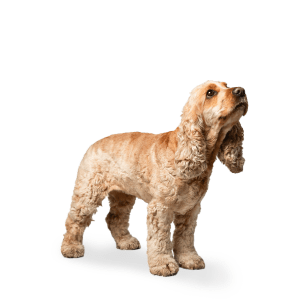

Perianal Fistula in Dogs
Frustrating for owners and a literal pain in the bum for dogs - most often German Shepherds - perianal fistula, also called anal furunculosis, is a chronic disease that’s no laughing matter. Painful holes and cracks form in the skin around the bum, sometimes connecting into networks of tunnels that leak fluid and refuse to heal.
Sadly, because the condition is immune-mediated, not a ‘simple’ infection, treatment isn’t always straightforward. But with careful management, many dogs can comfortably begin wagging their tails again.
What is perianal fistula in dogs?
Perianal fistula and anal furunculosis are both used to describe painful tracts or tunnels that open in the skin around the bottom. While a fistula is technically an abnormal connection—in this case between the body surface and the rectum—many tracts do not connect with the rectum. In practice, it’s just a technical distinction: both terms describe the same disease.
What makes a perianal fistula different from a simple wound is the way it develops. When infection is under control and the area is clean, instead of healing, the body’s immune system continues to attack the area. This creates chronic inflammation, scarring, and ongoing ulceration. Secondary infections are common, but they’re not the root cause. This is why treating infection alone isn’t enough.
Symptoms of perianal fistula
The obvious sign is the presence of holes, wounds, or inflamed skin around the anus. But if you can’t check safely, the following signs suggest it’s time for a vet visit:
- Excessive licking under the tail
- Straining or reluctance to poo
- Poop with blood or mucus
- Discomfort when sitting, wagging, or touched
- Unpleasant smell or discharge
- Behavioural changes such as depression or irritability
- In severe cases, incontinence

Perianal fistula in dogs causes
Perianal fistula is a complex problem, but the simplest way to think about it is this: genetics set the stage, the immune system drives the process, and risk factors like anatomy, allergies, or infection add fuel to the fire.
The condition is seen most often in German Shepherds, strongly suggesting genetic predisposition. It’s also immune-mediated, meaning the immune system mistakenly attacks healthy tissue in the perianal region. Why this happens isn’t fully understood.
Certain dogs are at higher risk:
- Breed: German Shepherds are by far the most commonly affected, though other breeds can develop it.
- Sex: Intact (entire) males develop it more often than neutered males or females.
-
Age: Middle-aged and older dogs are most commonly affected.
Other factors don’t directly cause perianal fistulas, but can worsen it or trigger flare-ups:
- A broad, low-carried tail that traps moisture
- Anal gland impaction or infection
- Food allergies or skin sensitivities
- Secondary bacterial infections
How to treat perianal fistula in dogs
Managing perianal fistulas requires patience and long-term commitment; there’s no simple cure.
Medical treatment
The gold standard today is medical management. Immunosuppressive drugs such as ciclosporin reduce the immune system’s attack on tissues. In some cases, topical treatments may be used as well, or between flare-ups. These medicines need to be given long-term, sometimes for life, and because they reduce immune function, your pup needs careful monitoring.
Surgery
In the past, surgery was often the only option. While it can still play a role — especially if the anal glands are involved — surgery carries risks. The anal area is delicate, and poor wound healing, infection, or even faecal incontinence are known complications. For this reason, surgery is generally reserved for cases where medical treatment fails.
Supportive care
Supportive measures keep your pup as comfortable as possible while the immunosuppressive drugs do their job:
- Stool softeners to reduce straining and pain during defecation
- Pain relief to make the dog more comfortable day-to-day
-
Antibiotics if a secondary infection is present
Owners may also be advised to keep the area clean (if it’s safe to do so), use protective ointments, and prevent excessive licking.
How to improve your dog’s gut health
While immunosuppressive drugs are the only truly effective treatment, gut health is an important part of long-term management. Both the condition and long-term medication can disrupt digestion, leading to inappetence, dog constipation, stress, or inflammation. At the same time, because the immune system drives the process and allergies can worsen it, reducing gut inflammation can help moderate the disease and improve your dog’s comfort.
A plan focused on soothing the gut and encouraging regular pooping can help:
- Highly palatable, easily digestible, hypoallergenic food to reduce potential triggers and encourage eating.
- Probiotics for dogs to support a healthy balance of gut bacteria and help modulate immune responses.
-
Fibre supplements to promote regular bowel movements and reduce straining. Read our guide to the benefits of fibre for dogs.
Living with perianal fistula
Managing perianal fistulas can be frustrating, but you don’t have to do it alone. While keeping the area clean and dry sounds good in theory, it’s not always possible, especially with a large, strong dog in pain. The key to management is teamwork, early action, and the right medication.
Regular check-ins—such as weekly or monthly nurse appointments—can help track progress with photo diaries, potty logs, and pain scoring. Many owners become skilled at spotting subtle changes, and catching a flare-up early means treatment can be adjusted before things spiral.
Key takeaway
Perianal fistula, or anal furunculosis, is usually a lifelong condition. The aim of treatment isn’t a permanent cure but remission, comfort and a good quality of life. Flare-ups happen, but with awareness, timely treatment, and veterinary support, many dogs live happy, active lives for years.



